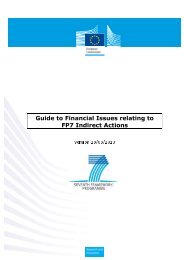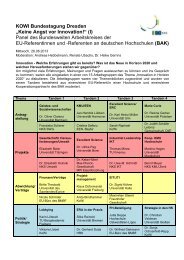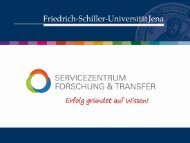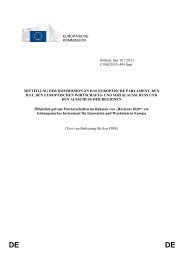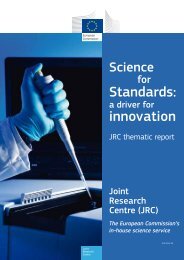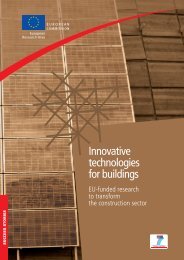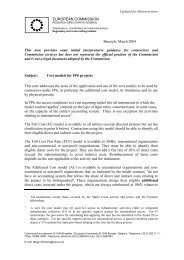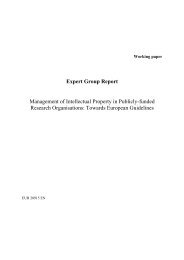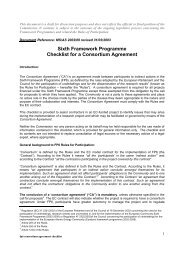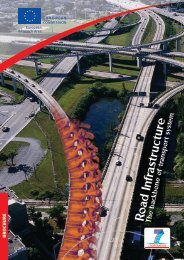Joint Ownership in Intellectual Property Rights - KoWi
Joint Ownership in Intellectual Property Rights - KoWi
Joint Ownership in Intellectual Property Rights - KoWi
You also want an ePaper? Increase the reach of your titles
YUMPU automatically turns print PDFs into web optimized ePapers that Google loves.
The IPR-Helpdesk is a project of the European Commission DG Enterprise,<br />
co-f<strong>in</strong>anced with<strong>in</strong> the fifth framework programme of the European Community<br />
ration of various persons, the right to apply for a patent belongs to all of them. Section 72 of the Law regulates the <strong>Jo<strong>in</strong>t</strong><br />
<strong>Ownership</strong> and exploitation of patent rights belong<strong>in</strong>g to various persons pro <strong>in</strong>diviso (<strong>in</strong> undivided parts). In this sense, Section<br />
74.3 (with<strong>in</strong> Chapter II, Transfer and Contractual Licenses) provides that for the purposes of assignment or transfer,<br />
patent applications and patents already granted shall be <strong>in</strong>divisible, even though they can belong jo<strong>in</strong>tly to several persons;<br />
i.e., the patent as a whole can belong jo<strong>in</strong>tly to various persons, but it cannot be divided, e.g., by claims be<strong>in</strong>g licensed claim<br />
by claim to various persons.<br />
Claim<strong>in</strong>g co-ownership: As under the general regime (where a person authorized to obta<strong>in</strong> a patent may claim the transfer of<br />
the patent where it has been unduly granted to another), a person only hav<strong>in</strong>g the right to part of a patent may not claim<br />
more than co-ownership of such a patent (Section 12 paragraph 2).<br />
Furthermore, the Sections of the Spanish Civil Code concern<strong>in</strong>g <strong>Jo<strong>in</strong>t</strong> <strong>Ownership</strong> (Sections 392 to 406) are also applicable.<br />
The regulation of this issue <strong>in</strong> the Spanish system thus provides that the <strong>Jo<strong>in</strong>t</strong> <strong>Ownership</strong> of patent rights will be governed by<br />
(Section 72):<br />
- The agreement between the parties.<br />
- In its absence: The relevant Sections of the Patent Law.<br />
- And ultimately, the Common Law provisions on <strong>Jo<strong>in</strong>t</strong> <strong>Ownership</strong> (Civil Code).<br />
Accord<strong>in</strong>g to Section 10 paragraph 1 of the Spanish Patent and Utility Model Law, the patent right belongs to the <strong>in</strong>ventor.<br />
So the first, and simplest, case of <strong>Jo<strong>in</strong>t</strong> <strong>Ownership</strong> is where various <strong>in</strong>ventors collaborate to make the same <strong>in</strong>vention. The<br />
<strong>in</strong>ventors can jo<strong>in</strong>tly apply for a patent and will be its jo<strong>in</strong>t owners. A second possibility is where one <strong>in</strong>ventor transfers his<br />
rights to more than one person. The transferees will also be jo<strong>in</strong>t owners of the patent, without be<strong>in</strong>g its <strong>in</strong>ventors, and the<br />
related provisions will apply to them.<br />
If the co-<strong>in</strong>ventors decide they wish to own the patent jo<strong>in</strong>tly, they should apply for it jo<strong>in</strong>tly. Otherwise, the co-<strong>in</strong>ventors<br />
could transfer their shares to one co-<strong>in</strong>ventor. In this case, the <strong>Jo<strong>in</strong>t</strong> <strong>Ownership</strong> will be dissolved and only one co-<strong>in</strong>ventor<br />
will own the patent right and therefore appear on the application form as the sole patent applicant. In any event, the co<strong>in</strong>ventors<br />
have the right to be designated as such (i.e., as co-<strong>in</strong>ventors).<br />
Accord<strong>in</strong>g to Section 72 paragraph 2, one of the jo<strong>in</strong>t owners can exploit the <strong>in</strong>vention by himself, with the sole requirement<br />
of previously notify<strong>in</strong>g the rest of jo<strong>in</strong>t owners. Section 394 of the Spanish Civil Code is also applicable <strong>in</strong> this case, and thus<br />
the jo<strong>in</strong>t owner's exploitation shall not cause damage to the community's <strong>in</strong>terests nor prevent the other jo<strong>in</strong>t owners from<br />
exploit<strong>in</strong>g the patent. It is important to note that the mean<strong>in</strong>g of exploitation shall be <strong>in</strong>terpreted here <strong>in</strong> relation with paragraph<br />
3 of Section 72. In this sense, Section 72.2.(b) recognizes that each of the co-owners has the right to work the <strong>in</strong>vention<br />
(explotar <strong>in</strong> the orig<strong>in</strong>al Spanish version), whereas Section 72.3 states that any licenses shall be granted by all the parties<br />
jo<strong>in</strong>tly, unless the presid<strong>in</strong>g judge grants this possibility to one of the parties <strong>in</strong> particular, for reasons of equity. This <strong>in</strong>terpretation<br />
of paragraph 3 of Section 72 is based on the fact that the patent is, by nature, not divisible, and thus the various<br />
jo<strong>in</strong>t owners of a patent do not have equal shares of it but a participation <strong>in</strong> the patent as a whole. This leads to the conclusion<br />
that without notification to other owners, a s<strong>in</strong>gle co-owner is only entitled to directly use and exploit the <strong>in</strong>vention by<br />
himself. "Exploitation" does not <strong>in</strong>clude "licenc<strong>in</strong>g" <strong>in</strong> this case.<br />
The jo<strong>in</strong>t owner who decides to br<strong>in</strong>g a civil or crim<strong>in</strong>al action aga<strong>in</strong>st third parties <strong>in</strong> order to protect the jo<strong>in</strong>tly owned patent<br />
or the patent application, shall give prior notice to the rest of the jo<strong>in</strong>t owners so that they can jo<strong>in</strong> the action. If they fail to do<br />
so, accord<strong>in</strong>g to the jurisprudence of the Spanish Supreme Court, a favourable decision will be to the advantage of all jo<strong>in</strong>t<br />
owners, while a negative result will not affect the rest of the owners.<br />
3.6 UK patent law<br />
Under UK patent law the <strong>in</strong>ventor has the right to be granted a patent, although this right can be over-ridden if another person<br />
has a legally enforceable right to the <strong>in</strong>vention by virtue of an agreement with the <strong>in</strong>ventor or by virtue of law. I.e. the <strong>in</strong>vention<br />
belongs to the employer, if the <strong>in</strong>vention is made dur<strong>in</strong>g the course of an employee's duties and those duties are<br />
such that an <strong>in</strong>vention may be expected to result.<br />
If the applicant apply<strong>in</strong>g for the patent (a natural person or a bus<strong>in</strong>ess entity) is different from the <strong>in</strong>ventor, the applicant must<br />
prove his right to the patent. Furthermore, the applicant has to identify the <strong>in</strong>ventor.<br />
Nevertheless, the UK Patent Act 1977 also allows co-ownership of patents <strong>in</strong> section 36, so applicants may make a jo<strong>in</strong>t application<br />
for a patent: Where a patent is granted to two or more persons, each of them shall, subject to any agreement to the<br />
contrary, be entitled to an equal undivided share <strong>in</strong> the patent. Each of them shall be entitled to use the <strong>in</strong>vention protected<br />
by the patent himself or through agents, for his own benefit and without the consent of or the need to account to the other<br />
co-owner(s).<br />
On the other hand, a sole co-owner may not, without the consent of the other co-owner(s), grant a licence under the patent<br />
or assign or mortgage a share <strong>in</strong> the patent or, <strong>in</strong> Scotland, cause or permit security to be granted over it. Where two or<br />
more persons are proprietors of a patent, anyone else may supply one of those persons with the means, relat<strong>in</strong>g to an essential<br />
element of the <strong>in</strong>vention, for putt<strong>in</strong>g the <strong>in</strong>vention <strong>in</strong>to effect, and the supply of those means by virtue of this subsection<br />
shall not amount to an <strong>in</strong>fr<strong>in</strong>gement of the patent.<br />
Where a patented product is disposed of by any of two or more proprietors to any person, that person and any other person<br />
claim<strong>in</strong>g through him shall be entitled to deal with the product <strong>in</strong> the same way as if it had been disposed of by a sole registered<br />
proprietor.<br />
- 14 -



